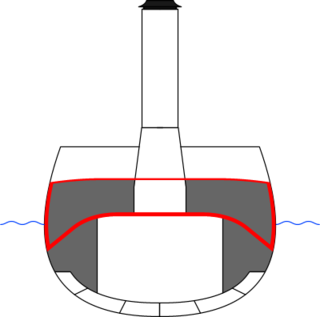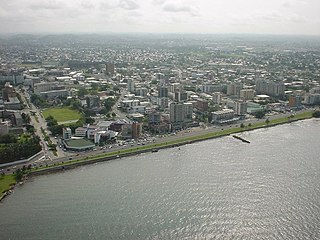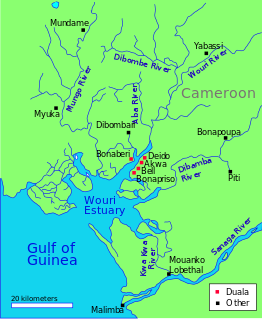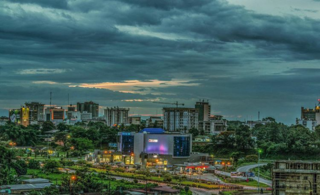
Togoland was a German Empire protectorate in West Africa from 1884 to 1914, encompassing what is now the nation of Togo and most of what is now the Volta Region of Ghana, approximately 77,355 km2 in size. During the period known as the "Scramble for Africa", the colony was established in 1884 and was gradually extended inland.
The Duala are an ethnic group of Cameroon. They primarily inhabit the littoral region to the coast and form a portion of the Sawabantu or "coastal peoples" of Cameroon. They have historically played a highly influential role in Cameroon due to their long contact with Europeans, high rate of education, and wealth gained over centuries as slave traders and landowners.

The Isubu are an ethnic group who inhabit part of the coast of Cameroon. Along with other coastal peoples, they belong to Cameroon's Sawa ethnic groups. They were one of the earliest Cameroonian peoples to make contact with Europeans, and over two centuries, they became influential traders and middlemen. Under the kings William I of Bimbia and Young King William, the Isubu formed a state called Bimbia.
German West Africa (Deutsch-Westafrika) was a rarely used designation for the German colonies in West Africa between 1884 and 1919. The term was normally used for the territories of Cameroon and Togo. German West Africa was not an administrative unit. However, in trade and in the vernacular the term was sometimes in use.
The Mulimba are an ethnic group of the Republic of Cameroon. They belong to the Sawa peoples, those of the Cameroonian coast.
George or Joss, born Doo a Makongo or Doo a Mukonga, was a king of the Duala people in the late 18th century. Doo a Makongo was the son of Makongo a Njo. He lived at Douala on the Wouri estuary on the coast of Cameroon. By 1788–1790, Doo was a powerful ruler in the area. During this time, the British slave trade was at its height, and Douala was the primary trading post in the region.
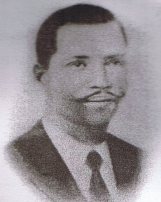
Rudolf Duala Manga Bell was a Duala king and resistance leader in the German colony of Kamerun (Cameroon). After being educated in both Kamerun and Europe, he succeeded his father Manga Ndumbe Bell on 2 September 1908, styling himself after European rulers, and generally supporting the colonial German authorities. He was quite wealthy and educated, although his father left him a substantial debt.
Auguste Manga Ndumbe Bell was a leader of the Duala people of southern Cameroon from 1897 to 1908 during the period after the German colonialists assumed control of the region as the Kamerun colony.

Ndumbé Lobé Bell or King Bell was a leader of the Duala people in Southern Cameroon during the period when the Germans established their colony of Kamerun. He was an astute politician and a highly successful businessman.
The Battle of Jabassi or Battle of Yabassi was a pair of assaults on German positions at Jabassi on the Wuri river during the Kamerun Campaign of World War I between German and British forces on 7 and 14 October 1914. The action resulted in British victory and their occupation of the station.

SMS Bismarck was a Bismarck-class corvette built for the German Imperial Navy in the late 1870s. She was the lead ship of her class, which included five other vessels. The Bismarck-class corvettes were ordered as part of a major naval construction program in the early 1870s, and she was designed to serve as a fleet scout and on extended tours in Germany's colonial empire. Bismarck was laid down in November 1875, launched in July 1877, and was commissioned into the fleet in August 1878. She was armed with a battery of sixteen 15 cm (5.9 in) guns and had a full ship rig to supplement her steam engine on long cruises abroad.
The Battle of Ukoko took place on 21 September 1914 during the Kamerun Campaign of the First World War between French and German troops in Ukoko, Kamerun or modern day Cocobeach, Gabon.
The Second Battle of Edea was the German counter-attack against French forces stationed in the village of Edea during the Kamerun Campaign of the First World War. Allied forces from Duala occupied the town following the First Battle of Edea in October 1914. The Germans, eager to retake the position attacked on 5 January 1915 but were repulsed by the French force.
The Second Battle of Jaunde involved the successful British and French assault on the German capital of Jaunde during the Kamerun Campaign of the First World War. After the failure of the First Battle of Jaunde during the summer of 1915, the bulk of Allied forces had retreated to the Kele river. Following the Second Duala Conference where Allied commanders discussed the situation, it was decided that another assault should be attempted. Although the columns surrounding Jaunde were not in effective communication with one another, on 1 January 1916, British forces under Colonel Georges occupied the capital. By this time it had been abandoned by the German troops who had fled to the neutral Spanish colony of Rio Muni. This Allied victory signaled the end of German resistance in Kamerun apart from the Siege of Mora which would continue for another few months.
The First Battle of Edea involved the British and French assault on German forces stationed in the village of Edea during the Kamerun Campaign of the First World War. Allied forces from Duala launched their advance on 20 October. Following stiff resistance along the southern railway line between Duala and Edea, German forces withdrew from the town to Jaunde, allowing Allied troops to finally occupy Edea on 26 October 1914.





